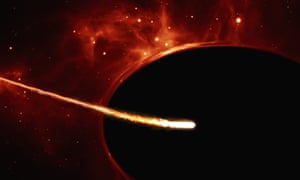It was one of the most spectacular deaths in the known universe: an enormous star in a distant galaxy met its doom and as a parting shot released a brilliant flash of light half a trillion times brighter than the sun.
The cosmic display was described as a record-breaking supernova by astronomers who studied the event last year. But according to fresh observations, this was no common or garden stellar explosion. Instead, the intense burst of light which outshone the whole Milky Way came from a star that suffered a much rarer fate: death by supermassive black hole.
Stars explode at the end of their natural lives about once every 50 years in a galaxy the size of the Milky Way. But the latest observations have led scientists to suspect that a star wandered too close to a spinning supermassive black hole and, having been caught in formidable gravitational forces, suffered the violent consequences.
“A supermassive black hole exerts enormous tidal forces on any star that comes too close and basically rips the star apart,” said Giorgos Leloudas, who led the study at the Weizmann Institute of Science in Rehovot, Israel.
The international team trained a network of land and space telescopes, including the European Southern Observatory and Nasa’s Hubble telescope, on the bright point of light for 10 months. The event, named “ASASSN-15lh” after the All-Sky Automated Survey for SuperNovae, played out in a galaxy 4bn light years from Earth.
Leloudas found that the star went through three distinct phases which closely resembled what is thought to happen when a star is “spaghettified” by a black hole. Rather than going out with a bang, the amount of ultraviolet light and heat coming from the star rose over time, in contrast to what is seen in supernova explosions. More evidence for the death-by-black-hole theory lay in the star’s home galaxy, described by Leloudas as “red and dead”, as opposed to the vibrant blue galaxies where active stellar nurseries are still creating new stars.
“We’ve always found supernovae in very blue galaxies, which are star forming galaxies full of young and massive stars like the ones you expect to explode. This is a red and dead galaxy, and very massive, where you don’t expect to find any stars that will give supernova explosions. That’s strong evidence against a supernova,” Leloudas said.
Writing in the journal Nature Astronomy, Leloudas and his team describe how a small star was probably ripped apart by a process that is more violent that its name, tidal disruption, might suggest.
In straying too close the spinning, supermassive black hole, the star was torn into its constituent gases. Over time, these formed a ring around the black hole and eventually fell inside, heating up and releasing immense streams of light and radiation as they plunged through the black hole’s event horizon. “It’s an efficient mechanism for producing enormous amounts of light,” Leloudas said.
Astronomers have witnessed tidal disruption only about 10 times before. If Leloudas and his team are right, a spinning supermassive black hole at least 100 million times the mass of the sun must lurk at the centre of the far away galaxy where the star was engulfed. “It’s by far the most likely explanation,” Leloudas said.
Quelle: theguardian

